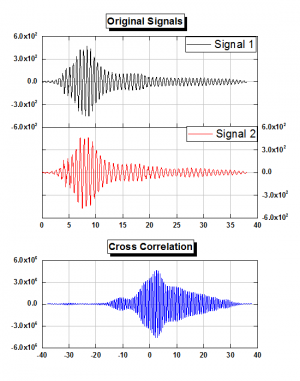18.8 CorrelationCorrelation

Correlation is a mathematical relationship between two random variables or signals. In Statistics, correlation can be thought of as a normalized covariance. A correlation of two identical signals is called an autocorrelation.
Correlation can be linear or circular. Generally speaking, linear correlation should be used when the input signals contain impulses, while circular correlation should be used when the signals repeat periodically.
Strength of correlation is expressed by a correlation coefficient. Let f(n) and g(n) be two signals of the same length, M. Their correlation coefficient can be defined as:

Note that if the input signals are not of the same length, the shorter one will be zero-padded to the length of the other signal. For linear correlation, the length of the result sequence is 2M-1, while the length of the result sequence for circular correlation is M.
The magnitude of the computed correlation coefficient shows the degree of similarity between the signals. If the magnitude is large, the two signals have a strong linear relationship. Alternatively, if the magnitude is small, the two signals can be considered to have little or no linear relationship.
If the correlation coefficient is normalized (the Normalize checkbox is selected), its absolute value will range from 0 to 1, making it easier to judge the similarity between the signals. If the normalized correlation coefficient is equal to either 1 or -1, the two signals are perfectly correlated.
The sign of the correlation coefficient indicates the direction of association. A positive correlation suggests that the change of one signal will cause the other signal to change in the same direction; a positive linear relationship. If the correlation is negative, a negative linear relationship exists; an increase in one signal will cause a decrease in the other.
To Use Correlation Tool
- Make a workbook or a graph active.
- Select Analysis: Signal Processing: Correlation from the Origin menu.
|
Topics covered in this section:
|
|